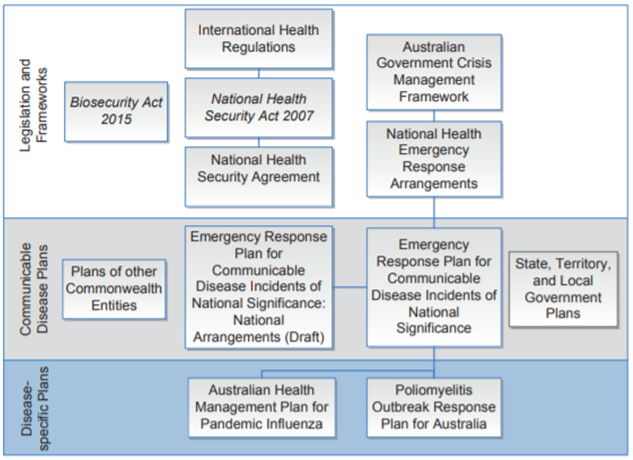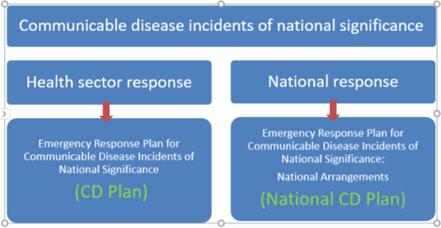Overview
Australia is required, under The
International Health Regulations (2005), to develop and maintain ‘capacity
to respond promptly and effectively to public health risks and public health
emergencies of international concern’ (Article 13).
Australia has a series of standing health emergency plans, ordered
from high level policy down to operational detail. Under these plans, state and
territory governments have primary responsibility for the management of
communicable disease emergencies; however, national (local, state, territory
and Australian Government) coordination is activated if a national response is
necessary. The plans are formally activated as required.
Since a pandemic affects not only the health sector but
virtually all other parts of the economy and society, the government planning
and administrative arrangements are necessarily complex.
This Quick Guide explains these arrangements, setting out
the plans (and supporting legislation). In each section, the Guide
distinguishes between ‘Australian’ (referring to Commonwealth bodies and
arrangements) and ‘national’ (referring to Commonwealth, state and territory
bodies and arrangements). The term ‘whole-of-government’ refers to all-agency
cooperation and can apply to either Australian or national or both.
The national
strategic approach to emergency management
The Australian
Emergency Management Arrangements (2019) outlines 11 emergency
management principles that provide guidance and a broad understanding of the
approaches to emergency management in Australia.
Australia’s strategic approach to emergency management
emphasises the importance of seeing the management of any hazard within an
ongoing cycle of activities in the four areas of Prevention, Preparedness,
Response, and Recovery. Every response plan is organised to
progress through those stages.
Australian
Government Disaster Response Plan
The COMDISPLAN
2017: Australian Government Disaster Response Plan (December 2017) is
the plan for the provision of Australian Government non-financial assistance
to Australian states and territories in an emergency or disaster. The Minister
with responsibility for emergency management must authorise approval for the
provision of Australian Government non-financial assistance.
COMDISPLAN explains how the Australian
Government responds to requests for assistance from state and territory governments responding to a disaster. It
can be activated for any disaster or emergency regardless of the cause.
Planning
framework
Figure 1 provides an outline of the interaction
of legislation, frameworks and plans relevant to the emergency management of communicable
disease. (Note that the Emergency
Response Plan for Communicable Disease Incidents of National Significance:
National Arrangements is no longer a draft. See below.)
Figure 1: interaction of
legislation, frameworks and plans relevant to communicable disease

Source: Australian National Audit Office
(ANAO), Department of Health’s coordination of communicable
disease emergencies, Audit
report, 57, 2016–17, ANAO, Canberra, 2017, p. 18.
Parallel whole
of government and health sector emergency response plans
At each level of the health emergency response, there are
parallel planning documents for the whole-of-government response and the health
sector response. The highest level national whole-of-government plan is the Australian
Government Crisis Management Framework (December 2017) (AGCMF).
The highest level national health plan is the National Health
Emergency Response Arrangements (November 2011) (NatHealth
Arrangements). The NatHealth Arrangements direct how the Australian health
sector (incorporating state and territory health authorities and relevant
Commonwealth agencies) would work cooperatively and collaboratively to
contribute to the response to, and recovery from, emergencies of national
consequence.
At lower levels, the parallel plans often have similar names
which can be confusing. For example, the whole-of-government Emergency
Response Plan for Communicable Disease Incidents of National Significance:
National Arrangements: National CD Plan (May 2018) (the National CD
Plan) is the key planning and coordination document to guide cross-government
arrangements, and it operates in parallel with the key health sector
coordinating document, the Emergency
Response Plan for Communicable Disease Incidents of National Significance
(September 2016) (the CD Plan) (Figure 2).
Figure 2: parallel health sector
and whole-of-government CD plans

Source: National CD Plan, p. 4.
Communicable
Disease Incident of National Significance
Communicable disease emergencies have unique characteristics
which affect planning and response. These are described at pages 19–20 of the
National CD Plan. In particular, these emergencies have the potential to
overwhelm systems for managing disease. An effective response requires high
levels of pre-planning and coordination.
A communicable disease emergency is initially managed at a
local, state and territory level. Once it reaches a level that requires
implementation of national health policy, national interventions and public
messaging, or deployment of Commonwealth or inter-jurisdictional resources to
assist affected jurisdictions, it is declared a Communicable Disease Incident
of National Significance (CDINS) which is the trigger for activation of
the CD Plan.
Once a CDINS requires national
whole-of-government coordination, the National CD Plan is activated. The
National CD Plan activates the AGCMF and the health emergency response is then managed
within the AGCMF. The AGCMF identifies the lead ministers for response to, and
recovery from, a crisis. It also designates a series of key Commonwealth and
national cross-government committees.
National Pandemic
Influenza Plan
The Australian
Health Management Plan for Pandemic Influenza–AHPPMI (August 2019) (Pandemic
Influenza Plan) outlines Australia’s strategy to manage an influenza
pandemic and minimise its impact on the health of Australians and our health
system. Substantial changes
were made in 2014 to the Pandemic Influenza Plan to take into account the
recommendations of the Review of
Australia’s Health Sector Response to Pandemic (H1N1) 2009—Lessons Identified
and developments in the approach to pandemic response within the international
community. It was revised again and republished in August 2019.
A key goal of the Pandemic Influenza Plan is to ‘achieve a
response that is proportionate to the level of risk’:
A response that is appropriate to the level of impact the
emergency is likely to have on the community, and on vulnerable populations
within the community, will make the best use of the resources available and
minimise social disruption. (Page 18)
Strategic health
management tools
National
system of public health surveillance
The National Health
Security Act 2007 provides a national system of public health
surveillance to enhance the capacity of the Commonwealth and the states and
territories to identify, and respond to, public health events of national
significance.
As required under Article 4 of The International Health
Regulations (2005), the Act establishes a National Focal Point to liaise
with responsible Commonwealth, state or territory bodies, the World Health
Organization (WHO) and other countries in relation to public health events of
national significance.
National
Medical Stockpile
The National Medical Stockpile (the Stockpile) is managed by the Department of
Health. The stockpile is:
a strategic reserve of drugs,
vaccines, antidotes and protective equipment for use in the national response
to a public health emergency which could arise from natural causes or terrorist
activities. Items are stockpiled to increase Australia’s level of
self-sufficiency during a time of potential high global and domestic demand and
service delivery pressures.
Following a performance audit
by the Australian National Audit Office in 2014, a four year reform agenda was
implemented to improve the cost effectiveness of the stockpiling arrangements.
Declaration
of a human biosecurity emergency
The Biosecurity Act
2015 (Cth) gives the Commonwealth Minister for Health expansive powers
to issue directions and set requirements in order to combat a human biosecurity
emergency. The Governor-General declared a human
biosecurity emergency on 18 March 2020 (see the Parliamentary Library
Flagpost ‘COVID-19
human biosecurity emergency declaration explainer’ for more information).
Further
reading
B Bennett, T Carney and R Bailey, ‘Emergency
powers and pandemics: federalism and the management of public health
emergencies in Australia’, The University of Tasmania Law Review, 31(1),
2012, pp. 37–57.
T Carney, R Bailey and B Bennett, ‘Pandemic
planning as risk management: how fared the Australian federation?’, Journal
of Law and Medicine, 19(3) March 2012, pp. 550–568.